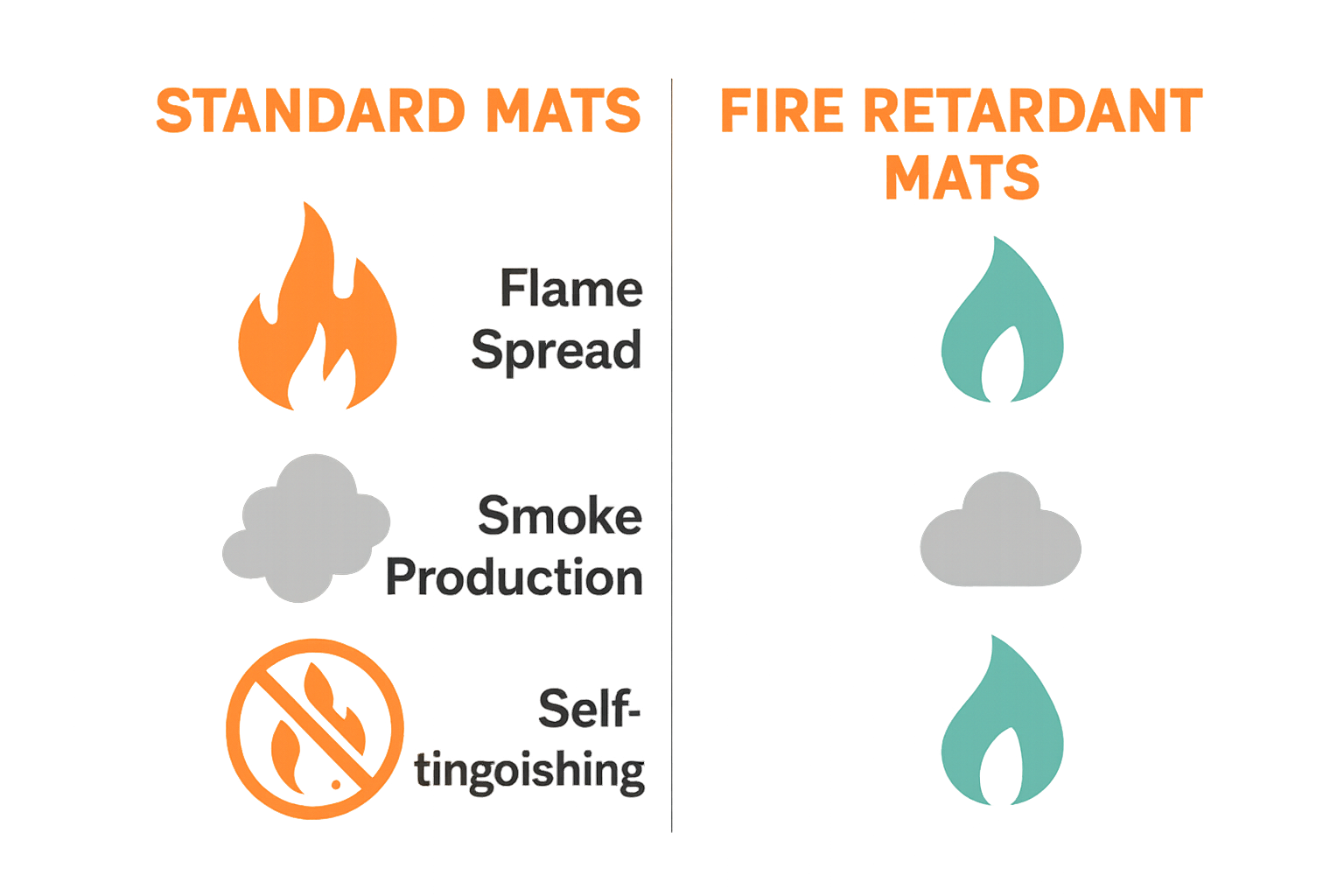Fire safety in busy workplaces is more than just alarms or signs. Some fire retardant floor mats can slow down flame spread by up to 70 percent compared to untreated options. People often assume that the real risk comes from furniture or curtains catching fire. Actually, the type of mat beneath your feet could be the single most vital barrier against disaster.
Table of Contents
- What Are Fire Retardant Floor Mats?
- Why Are Fire Retardant Floor Mats Important?
- How Do Fire Retardant Floor Mats Work?
- Key Concepts Related To Fire Retardant Materials
- Practical Applications Of Fire Retardant Floor Mats
Quick Summary
| Takeaway | Explanation |
|---|---|
| Fire retardant mats minimise fire risks. | They enhance safety in commercial and industrial settings by slowing flame spread and providing critical protection during fire incidents. |
| Chemical treatments improve fire resistance. | Specialised synthetic fibres are treated with flame-inhibiting chemicals, creating barriers that resist ignition and reduce combustion speed. |
| Meeting safety regulations is crucial. | Fire retardant floor mats help organisations comply with UK safety standards, demonstrating commitment to employee and visitor protection while reducing liabilities. |
| Effective in various environments. | These mats are essential for high-risk industries, healthcare facilities, and educational institutions, offering tailored protection against fire hazards. |
| Extended benefits through risk management. | Beyond fire safety, they protect flooring and minimise insurance costs, showcasing a proactive approach to safety and damage mitigation. |
What are Fire Retardant Floor Mats?
Fire retardant floor mats represent a specialised safety solution designed to minimise fire risks in commercial and industrial environments. These advanced matting systems are engineered with sophisticated materials and chemical treatments that significantly reduce flame spread and provide critical protection during potential fire incidents.
Chemical Composition and Fire Resistance
At their core, fire retardant floor mats are constructed using specialised synthetic fibres and polymers treated with unique flame-inhibiting chemicals. These treatments create a protective barrier that dramatically slows down combustion processes. According to the UK Government’s Fire Safety Risk Assessment Guidelines, such materials are crucial in preventing rapid fire propagation in commercial spaces.
The primary mechanisms of fire resistance include:

- Thermal Barrier Creation: Chemical treatments form a protective layer that resists immediate ignition
- Oxygen Reduction: Special compounds interrupt the combustion process by limiting oxygen interaction
- Self Extinguishing Properties: Materials designed to stop burning once the initial flame source is removed
Performance and Safety Standards
Fire retardant floor mats undergo rigorous testing to meet stringent UK safety regulations. These mats are typically classified according to specific fire resistance ratings, which determine their effectiveness in different environmental conditions. Professional facilities such as manufacturing plants, warehouses, healthcare institutions, and educational establishments rely on these specialised mats to enhance overall fire safety protocols.
By integrating fire retardant floor mats, organisations can significantly reduce potential fire risks while maintaining essential workplace safety standards.
The following table summarises key features and benefits of fire retardant floor mats as discussed in the article, providing a concise overview for readers considering their use in safety-critical environments.
| Feature or Benefit | Description |
|---|---|
| Fire mitigation | Slows down flame spread by up to 70 percent, reducing risk of rapid fire progression |
| Chemical treatment | Utilises specialised synthetic fibres and flame-inhibiting chemicals to create protective barriers |
| Regulatory compliance | Meets rigorous UK safety standards, aiding adherence to workplace safety regulations |
| Versatile application | Suitable for industrial, healthcare, and educational settings, offering broad protection |
| Floor protection | Shields flooring infrastructure from damage due to fire and related hazards |
| Insurance cost benefits | Reduces potential insurance liabilities through effective risk management |
| Reduced toxic smoke production | Minimises generation of harmful smoke during fire incidents, enhancing life safety measures |
Why are Fire Retardant Floor Mats Important?
Fire retardant floor mats play a crucial role in comprehensive safety strategies for commercial and industrial environments. These specialised protective surfaces are not merely accessories but critical safety interventions designed to mitigate potential fire risks and protect human lives and valuable assets.
Life Safety and Emergency Prevention
The primary importance of fire retardant floor mats lies in their ability to prevent rapid fire spread and provide critical moments during emergency scenarios. According to UK Government fire safety risk assessment guidelines, materials that resist ignition can significantly reduce potential catastrophic outcomes in commercial spaces.
Key life safety benefits include:
- Reducing Fire Propagation: Slowing down flame spread gives occupants more evacuation time
- Creating Protective Barriers: Limiting fire advancement through strategic material placement
- Minimising Toxic Smoke Generation: Specialised materials can reduce harmful smoke production
Regulatory Compliance and Workplace Protection
Beyond immediate safety concerns, fire retardant floor mats are essential for meeting stringent UK workplace safety regulations. Professional environments such as manufacturing facilities, laboratories, healthcare institutions, and educational establishments must adhere to strict fire safety standards. These mats represent a proactive approach to risk management, demonstrating an organisation’s commitment to employee and visitor protection.
Moreover, these mats offer additional benefits by protecting expensive flooring infrastructure and reducing potential insurance liabilities. Learn more about our comprehensive commercial mat cleaning strategies that help maintain the long-term effectiveness of these critical safety solutions.
How do Fire Retardant Floor Mats Work?
Fire retardant floor mats employ sophisticated scientific principles to interrupt and slow down potential fire progression. Their functionality is rooted in advanced material engineering and chemical treatments designed to provide critical protection in commercial and industrial environments.
Chemical Interaction and Fire Suppression
The core mechanism of fire retardant floor mats involves complex chemical interactions that disrupt traditional combustion processes. According to UK Government fire safety risk assessment guidelines, these materials are engineered to resist ignition and limit flame spread.
Key chemical suppression mechanisms include:
- Thermal Decomposition Interruption: Specialised chemicals break down heat transfer pathways
- Radical Scavenging: Neutralising free radicals that sustain combustion
- Char Formation: Creating protective carbon layers that block oxygen interaction
Material Composition and Reactive Properties
Fire retardant floor mats are constructed using specially treated synthetic polymers and fibres with intrinsic flame-resistant properties. These materials undergo precise engineering to ensure they react predictably when exposed to heat or direct flame sources. The reactive properties include immediate self extinguishing capabilities and minimal smoke generation.
Professional environments can benefit from understanding how these mats function as active safety components rather than passive floor coverings.
The following table outlines key fire resistance mechanisms found in fire retardant floor mats, helping readers understand how these products provide improved safety in emergency scenarios.
| Fire Resistance Mechanism | How It Works |
|---|---|
| Thermal barrier creation | Forms a protective layer that delays ignition and heat penetration |
| Oxygen reduction | Special compounds restrict oxygen interaction to suppress combustion |
| Self-extinguishing action | Material stops burning immediately once the flame source is removed |
| Thermal decomposition break | Chemicals disrupt heat transfer, breaking the chain of combustion |
| Radical scavenging | Neutralises free radicals to prevent fire from sustaining itself |
| Char formation | Develops a carbon-rich layer that isolates material from oxygen and flame |
| Minimal smoke generation | Designed to reduce the production of toxic or visible smoke during fire incidents |
Key Concepts Related to Fire Retardant Materials
Understanding fire retardant materials requires exploring complex scientific principles and engineering innovations that contribute to enhanced safety across various industrial and commercial environments. These materials represent a sophisticated intersection of chemistry, material science, and safety engineering.
Chemical Composition and Classification
Fire retardant materials are precisely engineered substances designed to resist ignition, slow flame spread, and minimise potential fire damage. According to UK Government fire safety risk assessment guidelines, these materials undergo rigorous testing to ensure their protective capabilities.
Key classification criteria include:
- Flame Spread Index: Measuring how quickly flames propagate across material surfaces
- Smoke Development Rating: Assessing potential toxic smoke generation
- Self Extinguishing Properties: Evaluating material behaviour after flame removal
Performance Standards and Regulatory Compliance
Fire retardant materials must meet stringent UK and European safety standards that define their effectiveness and reliability. These standards encompass comprehensive testing protocols that simulate real world fire scenarios, ensuring materials perform consistently under different environmental conditions.
Professional sectors such as construction, transportation, healthcare, and manufacturing rely on these materials to maintain critical safety infrastructure. Explore our comprehensive guide to specialised mat technologies to understand how advanced materials contribute to comprehensive safety strategies.
Practical Applications of Fire Retardant Floor Mats
Fire retardant floor mats serve critical safety functions across diverse professional environments, providing strategic protection beyond conventional floor coverings. These specialised materials are engineered to deliver comprehensive risk mitigation in scenarios where fire prevention can mean the difference between safety and catastrophe.
Industrial and Manufacturing Environments
In high risk industrial settings such as manufacturing plants, chemical processing facilities, and warehouses, fire retardant floor mats play a crucial protective role. According to London Fire Brigade safety recommendations, strategic placement of fire resistant materials can significantly reduce potential fire propagation risks.
Key industrial applications include:
- Welding and Metalworking Zones: Protecting floor surfaces from sparks and high temperature exposure
- Chemical Processing Areas: Creating barriers against potential chemical spillage and ignition
- Electrical Equipment Spaces: Minimising fire risks around sensitive electrical infrastructure
Healthcare and Educational Institutional Safety
Healthcare facilities and educational institutions require stringent fire safety protocols. Fire retardant floor mats provide an additional layer of protection in high traffic areas where multiple safety considerations intersect. These mats not only resist flame spread but also minimise toxic smoke generation, crucial in environments with vulnerable populations.
Professional safety managers can explore comprehensive mat technology solutions to enhance their institutional safety strategies, ensuring comprehensive protection across various operational environments.

Safeguard Your Facility With Certified Fire Retardant Matting
When every second counts in a fire emergency, the right protective flooring can make a crucial difference. As covered in our article, fire retardant floor mats are essential for slowing flame spread, reducing smoke, and offering the peace of mind that comes with effective risk prevention. If you are responsible for a hospital, clinic, or any space where safety standards must never be compromised, poor matting choices could leave your people and investments exposed.
Explore Hospital Mats designed for uncompromising fire safety

Make your next move a safe one. Visit Mats4U for expert advice and a wide selection of specialist floor mats, including custom-made solutions for hospitals and medical facilities. Choose fire retardant matting today and help protect everyone who walks through your doors.
Frequently Asked Questions
What are fire retardant floor mats?
Fire retardant floor mats are specialised safety solutions designed to minimise fire risks in commercial and industrial environments. They are constructed with advanced materials and chemical treatments that slow down flame spread and provide critical protection during potential fire incidents.
How do fire retardant floor mats work?
These mats employ advanced material engineering and chemical treatments to interrupt and slow down potential fire progression. They are designed to resist ignition and limit flame spread through mechanisms like thermal decomposition interruption and the formation of protective carbon layers that block oxygen interaction.
What are the safety standards for fire retardant floor mats?
Fire retardant floor mats must meet stringent safety regulations that define their effectiveness and reliability. They undergo rigorous testing based on criteria such as the Flame Spread Index, Smoke Development Rating, and self-extinguishing properties, ensuring they perform consistently in various environments.
In which environments are fire retardant floor mats used?
Fire retardant floor mats are commonly used in high-risk industrial settings such as manufacturing plants and chemical processing facilities, as well as in healthcare and educational institutions. They are crucial for enhancing fire safety protocols and reducing risks associated with rapid fire spread and toxic smoke generation.









